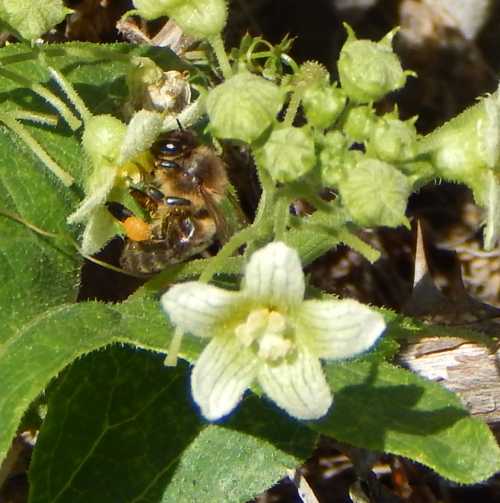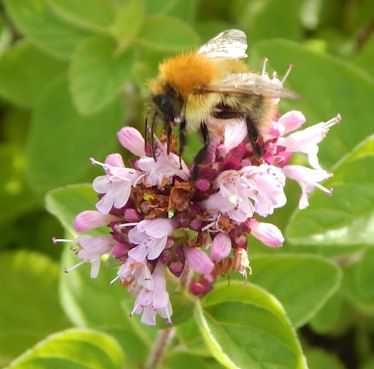Do Bees Have Lungs?
How Do Bees Breathe?
The short answer is:
Bees do not have lungs, but they have a system of tracheal sacs in the head, thorax and abdomen. The tracheal sacs function as air sacs.
To breathe bees take air into the tracheal system through 10 pairs of holes called spiracles.
Now for more detail!
Do Bees Have Lungs And How Do Bees Breathe?
The process of breathing in the animal Kingdom involves taking in air - oxygen, and expelling waste gas from the body in the form of carbon dioxide.
Of course, humans take in oxygen through the mouth or nose. The oxygen travels down a pipe called a trachea (sometimes called a 'wind pipe') to a pair of lungs in the chest and through to the blood stream, enabling the oxygen to be distributed around the body.
Insects like bees do not have lungs, so how do they breathe?

Respiration In Bees
Spiracles
Instead of taking in oxygen through the mouth and nose, bees have pairs of holes in the body called 'spiracles'. You could call them 'air holes'. There are 20 spiracles in total, arranged in a neat line along each side of the body.
- 3 pairs of spiracles on the upper body (thorax)
- 7 pairs of spiracles on the abdomen (1 of these pairs is located within the sting chamber).
The spiracles have valves which control the air flow in and out of the bee's body.
Trachea
Through these holes, oxygen is able to pass into the body of the bee into the tracheal system, which looks like a system of tubes around the body, that link the spiracles with air bags called tracheal sacs.
Tracheal sacs - air sacs for lungs
The tracheal sacs enable the distribution of oxygen to the head, the thorax, and to the abdomen where two large tracheal sacs are located on either side. The tracheal sacs have further connections to the legs.
In the process of breathing, air within the tracheal sacs is continually replenished by fresh air through contracting and relaxing of the abdomen. Air is forced out of the spiracles when the abdomen contracts, and new air is drawn back in again as the muscles in the abdomen relax.
So, in summary....
Bees do not have lungs, but they do have air sacs known as tracheal sacs, located in the head and through the body (thorax and abdomen).
Bees breathe by taking in air through 10 pairs of holes called spiracles, which are located in the thorax and abdomen.
As a bee contracts the muscles in its abdomen, old air is squeezed from the tracheal sacs and out through the spiracles. As the bee relaxes its abdomen again, fresh air is sucked in through the spiracles, and into the tracheal system where is it is distributed through to the head, thorax and abdomen.
Valves control the passing of air in and out of the spiracles.
Marcello Malpighi - Italian Scientist - (1628–1694)
Do other insects breathe?
Yes, but there are differences between insects - for example, whilst bees have 20 spiracles (air holes), butterflies and fruit flies have 18, but it's thanks to an Italian scientist born in 1628, Marcello Malpighi that we first began to learn about how insects breathe.
Malpighi discovered both the spiracles and also the tracheae that enable respiration in insects.
Spiracles and 'buzzing'
Back in 1912, a researcher called Sladen thought that the buzzing noise made by bees was caused by air passing over the edge of a membrane of the spiracles.
Nowadays the buzzing sound made by bees is largely associated with the rapid motion of a bee's wings.
Tracheal mite
The tracheal mite (Acarapis woodi) is a microscopic, internal mite which attacks the respiratory system of the honey bee.
It can infect the whole honey bee colony - queen, workers and drones.
The mite reproduces inside the trachea and feeds on the blood of the honey bee.
It has been found that tracheal mites damage flight muscles and spread bacteria into the blood of the bee. They may also cause dysentery in colonies, shorten the lifespan of bees and severely damage a colony and even cause losses of whole colonies.
Resources
- Kovac H, Stabentheiner A, Hetz SK, Petz M, Crailsheim K. Respiration of resting honeybees. J Insect Physiol. 2007;53(12):1250-1261. doi:10.1016/j.jinsphys.2007.06.019
- Honey Bee Tracheal Mite. https://www.clemson.edu/
- BAILEY.. The Respiratory Currents in the Tracheal System of the Adult Honey-BeeL. Journal of Experimental Biology 1954 31: 589-593
- Rozen, J.G. (2017). Structure and Functions of Spiracles of Mature Bee Larvae (Hymenoptera: Apoidea). Annals of the Entomological Society of America, 110, 417 - 421.
If you found this page helpful or interesting, I'd really be grateful if you would share it with others - if not this page, perhaps another, such as Gardening For Bees.
Thank you so much :) .

